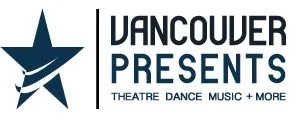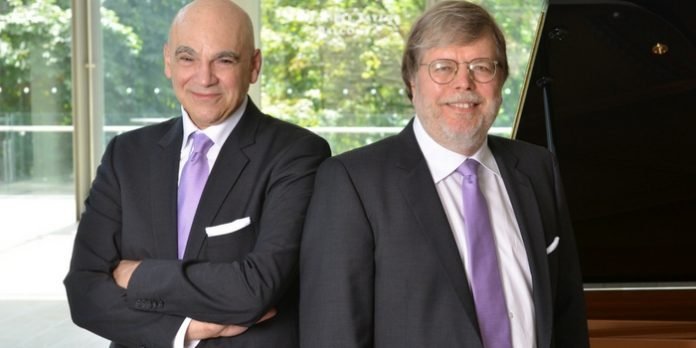Musicologist June Goldsmith founded Music in the Morning (MITM) in 1985. That’s when she first booked Anagnoson and Kinton. She had to ask how to pronounce James Anagnoson’s surname back then. Now, in 2019, this fine, world-class piano duo is a favourite with MITM audiences, and everyone knows how to pronounce Jim’s last name.
This season, the brown bag lunch and discussion after the performance, affectionately known as Noon with June, has been moved from Fridays at Christchurch Cathedral to Wednesdays at the Vancouver Music Academy. Noon with June (Goldsmith) provides an opportunity to learn more about the performers, their music, and how they approach it.
Things are a little different at this concert, however.
Both pianists speak eloquently about the music they play as part of their performance. They say this process not only enhances the audience’s appreciation of whatever they play, but it pares a piece down to its essence, and thus enhances their understanding and subsequent performance. “It also saves a great deal of program space,” the men chuckle.
They stumbled upon this format at a challenging gig early on in their careers. There had been much moving of pianos and not much compiling and printing of program notes. So the two experts offered to explain the composer’s intention to the audience as they went along. They’ve used the format ever since.
When Kinton explains the first concert item, Saint-Saens’s popular Danse Macabre, illustrated by appropriate examples on both keyboards en route, the storyline of the symphonic poem becomes crystal clear. It’s a delight to recognize the pivotal moments in the score that he’s pointed out too.
To clarify: First, Kinton walks everyone through a graveyard as the clock strikes midnight. “We often threaten to play thirteen strikes,” he jokes, “but we haven’t done it yet.” He continues, “Death appears, tuning his violin, discordantly, and invites the ghosts to rise from their tombs and burial chambers. The dance that follows gets more frenzied as the music progresses, and soon the whole graveyard is rocking. Then the cock crows and dawn breaks on the horizon. Death serenades the ghosts as they return to their graves. And as the graves close, the sun rises. Everything is just as it was before the moon rose in its place.”
The two men then play, and feet tap, toes curl, spines tingle, mouths twitch, and the odd tear appears. It’s terrific.
Anagnoson and Kinton are utterly different in appearance, personality and style. One hails from New York and the other from Toronto. One sits boldly upright at the piano while the other stoops and smiles a great deal. One is clean-shaven; the other is bearded. One prefers the piano stage left and the other stage right. One likes to play Primo, the other likes Secondo. One is more left brain, and the other is almost totally right. Even their sheet music sits differently on their respective pianos.
“But we think alike,” says Anagnoson. “And we respect each other’s ideas.”
“If one of us suggests something that the other doesn’t think will work,” says Kinton, “we would still go along and try it. Because we trust each other’s judgment, and we can joke together if it doesn’t work. It’s all about trust.”
That trust between these two miraculous musicians is undeniable. It apparently occurred from the moment they played their first piece together. It’s sheer joy to share the music they make together.
The rest of their program is just as enthralling and as meticulously and entertainingly explained. Poulenc’s Concerto for Two Pianos is said to go from crying to cackling in the twinkling of an eye. It does. What should follow it but Debussy’s own stunning two-piano version of another symphonic poem, Prelude to l’après-midi d’un faune (The Afternoon of a Faun).
“A faun.” Kinton explains, “is not a dear little deer as in Bambi. It is a satyr – half man/half goat. And it’s daydreaming about two lovely nymphs.”
“Nothing like Bambi,” chimes in Anagnoson.
The concert ends with Lutoslawski’s Variations on a Theme by Paganini – another show-stopper. When it begs an encore, the audience is treated to Gershwin’s Rhapsody in Blue. Nothing can follow that. It reverberates still. As does the entire Anagnoson and Kinton concert.
Anagnoson & Kinton perform on November 14 (Vancouver Academy of Music) and November 15 (Christ Church Cathedral) at 10:00 am on both days. Visit musicinthemorning.org for tickets and information.

